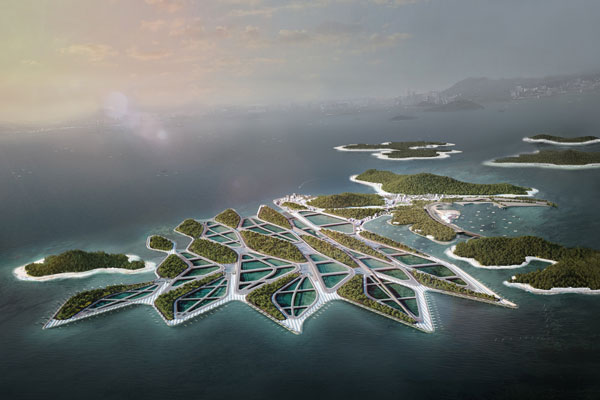10 Design’s Reclamation exhibition proposes alternative uses for land in one of the world’s densest and tallest cities.

March 20th, 2014
At the recent Hong Hong and Shenzhen Bi-City Biennale of UrbanismArchitecture, 10 Design presented three proposals in which a new, more sustainable urban habitat could be created in Hong Kong.
The first was a Vertical Farming Centre, centred around a 420m vertical farm that provides agricultural services as well as commercial and public spaces. Beyond the building, the surrounding wetland park would reclaim waste water, community gardens would allow people to grow their own food, and a farmers market would cater to the public. All waste would be upcycled, with food waste providing fertiliser or methane for power.
The Sunshine Bay fishery proposal then presented an alternative strategy for reclamation. The aquaculture landscape of interlinked active wetlands and low density fish ponds, supported by a structural artificial reef would actively clean and enrich the surrounding waters by filtering heavy metals and contaminants from the water while reintroducing vital nutrients and microorganisms, replenishing depleting fish supply and renewing Hong Kong marine habitats.
The third was a Methane project that proposed a closed system for food waste and energy whereby Hong Kong’s 3,500 daily tons of food waste is diverted from the landfill to a hybrid community centre and energy plant. The centre expands on the existing wholesale market in Cheung Sha Wan by including a methane power plant, public swimming pool heated by methane, and glowing methane balloons that generate enough electricity for 58,000 people while lighting up the Hong Kong skyline.
We find out more about the exhibition from Sean Quinn, Head of Sustainable Design at 10 Design.
Why did 10 Design choose to present an exhibition on the issue of ‘Reclamation’?
The theme of this year’s biennale was “Beyond the urban edge: ‘The Ideal City?’” When looking at the history of Hong Kong’s development the urban edge has continually shifted due to 150 years of reclamation, a development strategy that has distinguished the city but also resulted in tremendous environmental damage. We wanted to demonstrate a roadmap to mitigate much of the environmental footprint of a resource-intensive city, and introduce new modes of living in natural harmony [with the environment].
Why were these three proposals chosen?
Each proposal focused on an overstressed ecological resource in the context of a previous, current, and proposed area of reclamation.
How feasible are these proposals?
All the technologies illustrated in our proposal are available in some form today, and have been adapted to create dynamic experiences for the public. Each strategy has been evaluated for its environmental as well as economic service to illustrate the effectiveness if considered. Each solution is scalable. Vertical farm components could be applied to new or existing residential and commercial buildings, improving access to local food. A marine preserve would make good on the city’s promise to protect fish from the impact of reclamation. Methane generation could be implemented at any of Hong Kong’s landfills to provide energy for the city. While the final visuals may appear quite fantastic, the goal was to highlight many of Hong Kong’s urban issues, and introduce strategies that may initiate the path towards a more carbon neutral city.
10 DESIGN
10design.co
A searchable and comprehensive guide for specifying leading products and their suppliers
Keep up to date with the latest and greatest from our industry BFF's!

The Sub-Zero Wolf showrooms in Sydney and Melbourne provide a creative experience unlike any other. Now showcasing all-new product ranges, the showrooms present a unique perspective on the future of kitchens, homes and lifestyles.

Sub-Zero and Wolf’s prestigious Kitchen Design Contest (KDC) has celebrated the very best in kitchen innovation and aesthetics for three decades now. Recognising premier kitchen design professionals from around the globe, the KDC facilitates innovation, style and functionality that pushes boundaries.

Create a configuration to suit your needs with this curved collection.

Marylou Cafaro’s first trendjournal sparked a powerful, decades-long movement in joinery designs and finishes which eventually saw Australian design develop its independence and characteristic style. Now, polytec offers all-new insights into the future of Australian design.
The internet never sleeps! Here's the stuff you might have missed

As one of the many entries to The Social Space category at the 2024 INDE.Awards, this community centre is something out of the ordinary through its architectural design, that also provides a place for community and connection for many.

Paying homage to that wonderful tool of life, the book, SJK Architects’ design for the new headquarters of Penguin Random House is both a temple to the library and a captivating place to work.